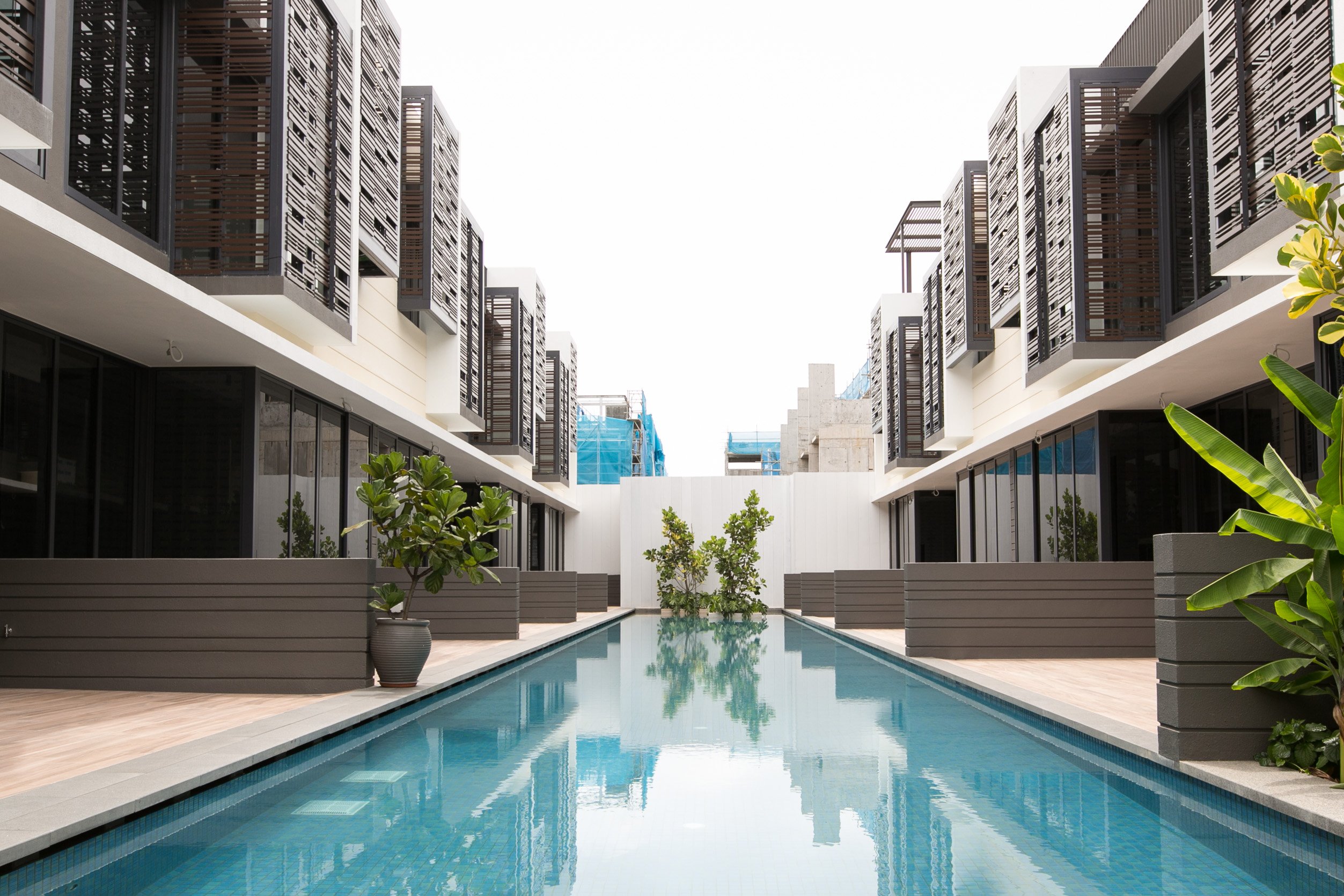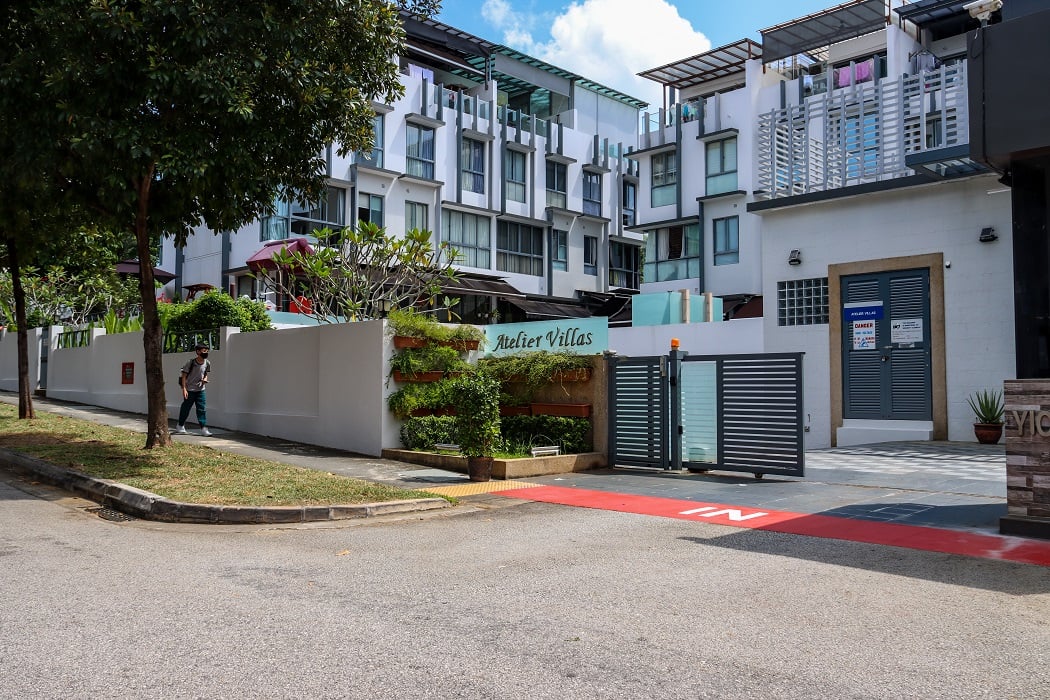While Singapore’s landed properties usually come at a premium, there is an affordable variety with the perks of condominium living – cluster homes or strata landed houses. We’ve covered a few comparisons and recommendations before.
In a broad sense, strata-landed houses are commonly associated with landed units, either within a cluster, or part of a condominium development. Both usually come with gated security and shared facilities.
Here’s a list of why cluster homes and/or strata landed homes in general, offer the best of both living in a high-rise condominium apartment and a landed house:
1. Condo-like facilities
Cluster houses or strata landed homes, are usually more affordable than non-strata landed houses. They come with condo-like communal facilities such as a gym, jacuzzi, playground and swimming pool. Essentially, it’s like having the best of both worlds at an affordable price point, with the space, privacy and appeal of landed estates.

2. Good class neighbourhoods
Cluster homes are strata-titled properties that can be built in landed housing estates such as Good Class Bungalow areas. This allows developers the latitude to erect multi-floor residences next to one, much like condo blocks, with the focus around a central facility such as a luxurious swimming pool. This gives the cluster home development a clean and vibrant villa-like neighbourhood, instead of one where different landed properties or bungalows look different and juxtaposed next to one another.

3. Different landed home configuration options
While high-rise condominium apartments are standardised based on room configurations, the landed houses in cluster housing projects offer low-rise options comprising terrace homes, semi-detached residences and bungalows. These housing units may be developed either individually or as a combination of all three, offering homeowners unique, different layouts.
This often makes cluster homes an excellent proposition for families looking for a beautiful landed housing facade, with a picturesque walkway and front door. Not only that, since the playground and swimming pool are within the compound, children can play freely with total privacy and safety. It also allows them to form bonds with their neighbours.
4. More affordable than non-strata landed property
Cluster houses are usually more affordable than a typical landed property, let alone maintaining one over several years. It is easier to find cluster homes costing under S$2 million, making them a constant sought-after property type for buyers, especially given that cluster houses are rare and in limited supply.
5. Larger space and high rental income
Cluster homes are also attractive to HDB upgraders who can afford larger spaces and want to live in landed housing. For landlords, they may realise better rental ratios since cluster homes are more affordable than pure landed houses, but their monthly rent is roughly similar to that of landed residences. It’s a win-win.
6. Rarity
Given Singapore’s land scarcity, why is the supply of cluster homes so rare if they are in demand? That’s because, in 2014, URA changed the development guidelines for strata landed housing, requiring builders to allocate at least 45 per cent of the site area for communal open space (compared to the 30 per cent requirement previously). Of this 45 per cent, a maximum of only 20 per cent can be used for communal facilities like playgrounds and swimming pools, while at least 25 per cent must be allocated to foliage and greenery.
It’s understandable then why developers are building fewer cluster homes, as this potentially means lesser space to build more units, which converts into lower margins with each unit sold.
7. Exclusivity and privacy
Compared to condo living, the common facilities in cluster developments are more exclusive. They are naturally shared by fewer people, given the smaller residential units than in a condo. Unlike owning landed property, they don’t have to worry about maintaining the exterior facade of their homes either, since maintenance of the external building and facilities is included in cluster home developments (similar to condominiums, owners must set up a non-profit corporation called a Management Corporation Strata Title (MCST)).
However, that typically means that the monthly maintenance charges in cluster homes tend to be higher than that in larger condos, as fewer people cover the costs of the shared facilities. As the strata-type development of cluster housing means this is collectively owned by all residents, they do have greater control over future additions and alterations to the project.
8. Ownership restrictions
However, it is worth noting that being a type of ‘strata-landed housing unit’, cluster housing projects are classified as restricted properties, and the Residential Property Act restricts foreign ownerships as cluster housing developments are not accorded condominium status, so foreigners will require prior approval before being able to purchase a cluster home.

In summary, cluster homes seem to be the more economically feasible option for homeowners who can spend a little more on their homes with fewer maintenance hassles. Compared to a bungalow or semi-detached house, they do save more in the long run. Given the rarity of cluster home projects in Singapore, it is also a lucrative investment for homeowners and landlords.
–
Looking to buy a cluster home or strata landed house? Let us know in the comments section below.
If you find this article helpful, 99.co recommends Strata landed housing: Reap the twin benefits of a landed home experience and the perks of condo living and The unique appeal of cluster homes – why some homeowners are drawn to them.
Looking for a property? Find the home of your dreams today on Singapore’s fastest-growing property portal 99.co! If you would like to estimate the potential value of your property, check out 99.co’s Property Value Tool for free. Meanwhile, if you have an interesting property-related story to share with us, drop us a message here — and we’ll review it and get back to you.
–
What’s the difference between cluster homes and strata landed houses?
In a broad sense, strata-landed houses are commonly associated with landed units, either within a cluster, or part of a condominium development. Both usually come with gated security and shared facilities. Cluster homes are strata-titled properties that can be built in landed housing estates such as Good Class Bungalow areas.
How are cluster homes different from pure landed homes?
Cluster houses or strata landed homes, are usually more affordable than non-strata landed houses. They come with condo-like communal facilities such as a gym, jacuzzi, playground and swimming pool. Essentially, it’s like having the best of both worlds at an affordable price point, with the space, privacy and appeal of landed estates.
Why are strata landed, and cluster homes rare in Singapore?
In 2014, URA changed the development guidelines for strata landed housing, requiring builders to allocate at least 45 per cent of the site area for communal open space (compared to the 30 per cent requirement previously). Of this 45 per cent, a maximum of only 20 per cent can be used for communal facilities like playgrounds and swimming pools, while at least 25 per cent must be allocated to foliage and greenery. It’s understandable then why developers are building fewer cluster homes, as this potentially means lesser space to build more units, which converts into lower margins with each unit sold.
The post 8 reasons why cluster homes or strata landed houses are worth buying appeared first on 99.co.

